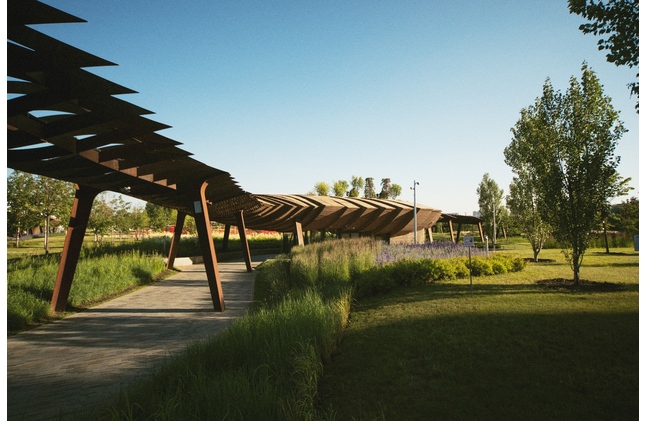
“Buildings, too, are children of Earth and Sun.” – Frank Lloyd Wright
As morning pours golden light across the lacework of leaves beyond your window, something awakens within. The soft rustle of a wind, the filtered light dappled on the floor, the smell of wood, the soft curve of a wall mirroring the riverbank—it is not merely beauty. It is a memory inscribed in our biology. It is nature beckoning us home.
This is the pulse of biophilic design, a philosophy that is not one of ornamentation, but of reconnection. In an age where cities rise vertically and screens mediate our existence, biophilic architecture challenges: What if our buildings breathed? What if we designed not to isolate us from the natural world—but to envelop us within it?
The Story Begins: From Cave Walls to Curtain Walls
Humans are not strangers to nature. We are its offspring.
From the earliest homes—mud houses huddled under forest cover, cave mouths bordering the savannah—to the verdant courtyard houses of ancient Persia and the villa open-air houses of Rome, architecture has long been intertwined with nature. But as modernism picked up pace, glass and steel started cutting the haptic, sensory ties we had so cherished.
Enter biophilic design—not trend, but rediscovery. Rediscovery of the fact that the more life we have in a space, the more alive we are in it.
Principles Rooted in the Earth
Fundamentally, biophilic design is not a matter of plunking in plants in the lobby. It’s about designing with life as a consideration, employing nature’s patterns, materials, light, and forms to create spaces that heal, inspire, and function.
The pillars of biophilic design are:
- Direct exposure to nature: Green walls, living roofs, indoor gardens, water features—nature indoors.
- Indirect exposure: Natural materials such as stone and wood, organic shapes, patterns inspired by leaf venation or rippling water.
- Space and place: Refuge and prospect, mystery and discovery—spaces that reflect our evolutionary habitats.
Case Study: The Office That Breathes
Picture entering an office in Singapore—not a fluorescent-lit cubicle complex, but a rainforest atrium filled with bird song and the aroma of orchids. This is the Marina One complex, where landscape and architecture merge, and where employees stop to catch their breath amidst cascading foliage.
Here, well-being isn’t an add-on—it’s built into the architecture itself. Research has found that exposure to nature in the workplace can decrease stress by 15%, boost productivity, and enhance creativity. In this building, the rainforest isn’t ornamentation—it’s infrastructure.
The Sensory Symphony of Biophilia
How does it feel to live in a biophilic space?
The sun warms the rammed earth wall and sends out a subtle, earthy heat. A skylight directs morning light onto your breakfast table. A passageway winds like the course of a river, with a new panorama unfolding with every step. Sound is muffled by moss-covered walls. A babbling fountain offers a bit older than words.
Biophilic design involves all five senses. It promotes mental acuity, emotional balance, and physical energy. And in a time of increasing anxiety, climate melancholy, and screen saturation, it reminds us: You are still connected to the Earth.
The Green Blueprint of the Future
Biophilic design is not just stunning—it is intelligent. It enhances:
- Sustainability: Through collaboration with passive solar design, daylighting, and natural ventilation.
- Resilience: Green roofs mitigate urban heat. Embodied carbon is reduced through natural materials.
- Community: Green public space fosters connection, equity, and mental health.
Around the world, we observe this movement blooming: from The High Line in New York, where an abandoned railway transformed into a meadow in the sky, to Bosco Verticale in Milan, where towers adorn forests like armor.
Conclusion: Designing for Our Deepest Needs
In architectural language, biophilic design is poetry. It addresses the limbic system, memory, instinct. It doesn’t merely protect us—it awakens us.
And as architects, designers, developers, or simply as inhabitants, we need to ask: can we build to heal the Earth, and ourselves? Can our cities throb with birdsong, with shade, with the smell of rain on leaves?
Biophilic design says yes.
Because we are not apart from nature. We are nature, reflecting back on itself—through the windows of our own making.
